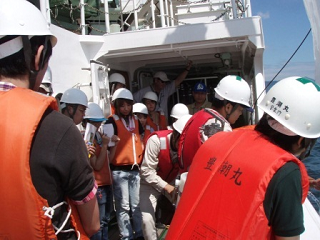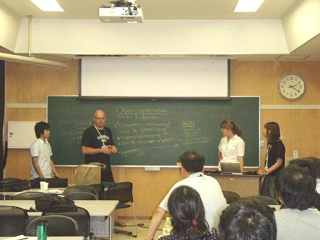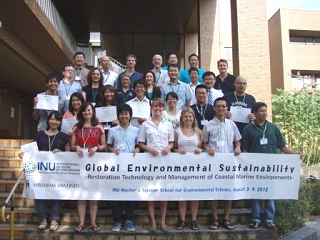INU Master’s Summer School 2013 for Environmental Science
Second INU Master’s Summer School for Environmental Science held in 2013 focused on how to prepare for ‘Climate Change and Coastal Disasters.’ We invited graduate students in relevant fields of study from INU member institutions to apply for this unique learning opportunity.
2013 TOPIC: “Global Environmental Sustainability: Preparing for Climate Change and Coastal Disasters”
[PROGRAM COMPONENTS]
・An intensive educational program with lectures and workshops;
・Academic experts and guest speakers from around the world;
・Field trip onboard of the research vessel Toyoshio Maru and visit to the marine research institutes in Hiroshima;
・Visit to Hiroshima Bay and Miyajima Island (world heritage);
・Interactive workshops with students from across the globe;
・An integrated cultural program that introduces a unique side of Hiroshima, which includes a visit to the Peace Memorial Museum and admission to attend the annual Hiroshima Peace Memorial Ceremony on 6 August.
[KEY EDUCATIONAL GOALS]
・To know the similarities and differences in local environmental issues related to climate change and coastal disaster through the presentations of the country case study reports and discussions.
・To learn how they are tackling the local environmental issues with regard to climate change and coastal disaster in Japan.
[CREDIT POINTS]
Hiroshima University students participating in this program receive the following credit points (cpt), if they wish:
・Academic Volunteer (1 cpt)
・Foreign Language Communication (A) (1 cpt)
・Presentation (A) (1 cpt)
IMPORTANT: The respective student’s supervisor is the person in charge of evaluating and deciding on the number of credit points deserved by his/her student.
**For foreign students, their respective universities decide on the credit points.
[ELIGIBILITY]
・Graduate students from INU member universities
・Must be able to attend lectures and participate in discussions conducted in English
・Must be able to attend all activities planned for the entire program
[PROGRAM PERIOD] 3 (Sat.)– 9 (Fri.) August, 2013
[PROGRAM SCHEDULE]
| Date | Activity |
| August 3 | “Ice-breaker”activities in Takehara City, visit to Takehara Marine Station, microscope observations, snorkeling, lecture, |
| August 4 | Introduction, presentation of country case-study reports by the attendants, and welcome reception |
| August 5 | Practice on-board of T/RV Toyoshio Maru (analysis of water and sediment quality, plankton sampling) |
| August 6 | Peace Memorial Ceremony continued by guest lectures (optional), Green Legacy Tour (optional) and visit to Peace Memorial Park and Museum (optional) |
| August 7 | Guest lectures on related topics/ Japanese Cultural Activity: ‘Zazen’ (Zen Mediation) or Karate (optional) |
| August 8 | One day tour to Itsukushima Shrine, Miyajima Aquarium, and Nat’l Res. Inst. Fish. Env. Inland Sea, Fish. Res. Agency |
| August 9 | Reports, discussion, certification, and farewell reception |
INU Master’s Summer School 2012 for Environmental Science
The INU Master’s Summer School that started in 2012, “Global Environmental Sustainability: Restoration Technology and Management of Coastal Marine Environment” was successfully carried out at Hiroshima University. The participants came from 9 schools total (8 were INU members), international and Japanese. Detailed information for the summer school program is found below:
[PARTICIPATING UNIVERSITIES] Hiroshima University, James Madison University (USA), Malmö University (Sweden), Kyung Hee University (Korea), Flinders University (Australia), Rovira i Virgili University (Spain), Catholic Parahyangan University (Indonesia), Ritsumeikan Asia Pacific University (Japan), and Griffith University (Australia)
[NUMBER OF ATTENDEES] 16 students (7 from abroad), and 16 teachers (7 from abroad)
[PROGRAM PERIOD] 3 (Fri.) – 9 (Thur.) August, 2012
[PROGRAM SCHEDULE]
| Date | Activity |
| August 3 | Country reports by students and welcome reception |
| August 4 | Fieldwork using R/TV Toyoshio-maru |
| August 5 | Observation of tidal flat restoration at the Seno River mouth and visit to an oyster shell processing firm |
| August 6 | Peace Memorial Ceremony, tour of A-bombed trees, and Peace Memorial Museum |
| August 7 | Miyajima Aquarium, Itsukushima Shrine, and National Fisheries Research Institute |
| August 8 | Lectures on seagrass bed restoration and protected marine area |
| August 9 | Group discussion and farewell reception |
There were very positive reports from participants, particularly student who participated in the Peace Memorial Ceremony and experienced sailing around the rich tide had a high level of interest.
Participating students voiced that they were able to identify differences and commonalities in coastal environmental issues and restorative technologies used in different countries. Students who at first were unable to speak quickly in English in the end reported that they were able to have a high level of communication. Foreign students were able to experience Japanese culture for the first time, and said that they absolutely wanted to come back to Japan. Even after the students returned to their home countries, they have continued to exchange information through email and Facebook.
In this manner, the summer school program was, not only for improving expertise in aquatic environmental sciences, but also for strengthening the international support for graduate students and Hiroshima University. Furthermore, it significantly contributed to the strengthening of internationalization for faculty and staff of Hiroshima University.

Sampling on board of the R/TV Toyoshio-maru.

Group discussion on Aug. 9th.

Group photo of the summer school participants.


 Home
Home